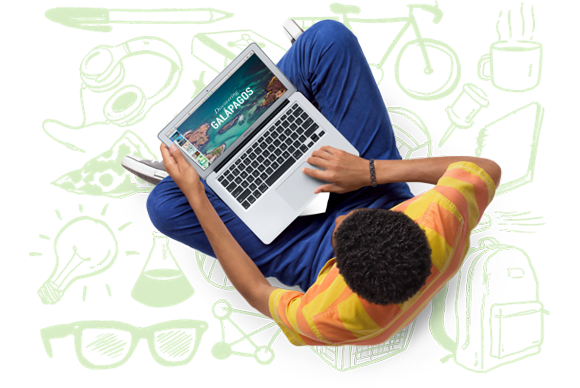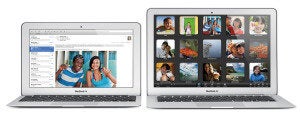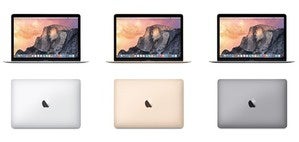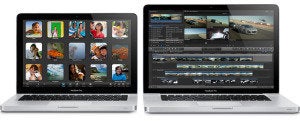

If you’re reading this article, chances are you’re thinking about buying a new Mac and may be in need of a little guidance. Fortunately, we’re quite familiar with Apple’s Macs, and we’re happy to help you choose the right Mac for you.
This buying guide provides an overview of all the Mac models available, and what each model is best suited for. To get more details, you can read the full review for each Mac model by clicking the “Read our complete review” links.
Quick reference chart: Apple’s current Mac laptop lineup
Quick reference chart: Apple’s current Mac desktop lineup
MacBook Air

What is it? The MacBook Air is Apple’s affordable line of laptops. It comes in two screen sizes: 11 inches (2.4 pounds) and 13 inches (3.0 pounds).
Who’s it for? The MacBook Air is ideal for the budget conscious. It’s also for anyone who is always on the go, doesn’t want to be bogged down by a regular-size laptop, and needs a computer that’s more versatile than an iPad.
What are the specifications? The four MacBook Airs have the same 1.6GHz dual-core Core i5 processor. All MacBook Air models come standard with 4GB of RAM and integrated Intel HD Graphics 6000 technology. Apple claims 9 hours wireless web/10 hours iTunes movie playback of battery life for the 11-inch models, and 12 hours for both wireless web and iTunes movie playback for the 13-inch models.
The main difference between the laptops is storage. The $899 11-inch model and the $999 13-inch model have 128GB of flash storage while the $1099 11-inch model and the $1199 13-inch model have 256GB.
How do I connect stuff? The MacBook Air has built-in Wi-Fi for connecting to a network. It also provides built-in Bluetooth for wirelessly connecting a mouse or other peripheral. If you want to connect to an ethernet network, you’ll need a USB ethernet Adapter.
Thunderbolt 2 is the MacBook Air’s high-speed connector. The laptop also has a pair of USB 3.0 ports, which can work with devices that use USB 2.0. If you have a FireWire 800 drive, you’ll need to buy a Thunderbolt-to-FireWire Adapter.
How fast is it? The MacBook Air is quite capable of handling everyday tasks, such as sending and receiving email, browsing the Web, and using office applications. You can even use it for editing short videos, or for working with JPEGs from your iPhone or point-and-shoot camera.
The MacBook Air’s flash storage really helps the performance. For example, the MacBook Air outperforms the 13-inch non-Retina MacBook Pro, which uses a hard drive (solid-state drives for the 13-inch non-Retina MacBook Pro are available for an additional cost).
Macworld’s buying advice: The MacBook Air is a great affordable laptop for someone who does general-purpose work and moves around a lot, such as a student or a self-employed person. Since the MacBook Air is at the lower end of Apple’s laptop lineup in terms of price, you won’t find the Retina display that’s in the Retina MacBook Pro or the MacBook. Also, you can’t easily upgrade the storage after purchase, so you should buy the model with the largest amount of storage you can afford. (After-market storage upgrades are available, but Apple does not provide support for such upgrades.)
Read our complete review of the MacBook Air (Early 2015)
MacBook

What is it? The MacBook is Apple’s latest entry in the ultra-portable laptop market. It’s actually lighter than the MacBook Air and smaller than the 13-inch MacBook Air.
Who’s it for? The MacBook is made for users who prioritize mobility over everything else, including features and performance.
What are the specifications? The MacBook comes in only one size: a 12-inch model available in space gray, gold, or silver.
There are two models of the MacBook. The $1299 model has a dual-core 1.1GHz Intel Core M processor and 256GB of flash storage. The $1599 model has a dual-core 1.2GHz Intel Core M processor and 512GB of flash storage.
Both models include 8GB of memory and an integrated Intel HD Graphics 5300 processor.
The MacBook has a Retina display, which means it has an ultra-high resolution display that’s capable of showing crisper images than on the MacBook Air, which has a standard display. The MacBook has a native resolution of 2304 by 1440 pixels and offers scaled resolutions of 1024 by 640, 1280 by 800, and 1440 by 900.
How do I connect stuff? The MacBook has Wi-Fi for connecting to a network and Bluetooth for your devices.
There’s only one USB-C port for connecting storage devices, printers, external displays, power adapters, or anything else. Since there are no USB-C peripherals available (as of this writing), you need to use a $19 USB-C to USB adapter that will allow you to connect USB 3 and USB 2 devices to the MacBook. Want to connect to ethernet? You need the USB-C to USB adapter and the $29 USB ethernet Adapter. If you want to connect an HDMI display and USB devices, you need to get the $79 USB-C Digital ACV Multiport Adapter. Or if you want to connect a VGA display, you need the $79 USB-C VGA Multiport Adapter.
How fast is it? The Intel Core M processor in the MacBook is made to be efficient and cool. That means it’s not a top-performing processor. In fact, the MacBook is the slowest of Apple’s laptop offerings.
That being said, it can handle everything your typical user does on a daily basis. It can even handle some high-end, professional production tasks. It just won’t be the fastest to the finish line.
Macworld’s buying advice: The MacBook is for anyone who’s constantly on the go and seldom needs to connect devices—be prepared to carry a bunch of adapters if you have to make connections. The MacBook seems like a good indicator of what direction Apple plans to go with its laptop line: thinner with fewer connectors. Even if you decide not to go with a MacBook, it’s good to take a look at it and prepare yourself for what’s coming.
Read our complete review of the MacBook (Early 2015)
MacBook Pro with Retina display
Apple sells two types of MacBook Pros. Let’s cover the Retina MacBook Pro first.

What is it? The Retina MacBook Pro features a high-density display with so many pixels that images and text look especially smooth and clean. At normal viewing distances, you can’t discern individual pixels.
Who’s it for? The Retina MacBook Pro is for the demanding user who wants a portable computer that also performs well. Retina MacBook Pro models sit at the top of the performance chart of Mac laptops.
What are the specifications? The Retina MacBook Pro is available in screen sizes of 13 inches and 15 inches.
There are three 13-inch models. The $1299 model has a 2.7GHz dual-core Core i5 processor, 8GB of memory, and 128GB of flash storage. The $1499 model has a 2.7GHz dual-core Core i5 processor, 8GB of memory, and 256GB of flash storage. The $1799 model has a 2.9GHz dual-core Core i5 processor, 8GB of memory, and 512GB of flash storage. All three 13-inch models have an Intel Iris Graphics integrated graphics processor.
Apple has two 15-inch Retina MacBook Pros. The $1999 model has a 2.2GHz quad-core Core i7 processor, 16GB of memory, 256GB of flash storage, and Intel Iris Pro integrated graphics. The $2499 model offers a 2.5GHz quad-core Core i7 processor, 16GB of memory, 512GB flash storage, Intel Iris Pro integrated graphics, and a discrete 2GB AMD Radeon R9 M370X graphics processor.
The screen is the Retina MacBook Pro’s marquee feature. The 13-inch Retina display has a native resolution of 2560 by 1600 pixels, and OS X offers a scaled resolution up to 1680 by 1050 pixels. The 15-inch Retina display has a native resolution of 2880 by 1800 pixels, and OS X’s highest scaled resolution on those laptops is 1920 by 1200 pixels. These high-scale resolutions can accommodate the workspace of a larger-screen standard Mac laptop on a smaller Retina MacBook Pro if you can tolerate the smaller icons, text, and other graphics on screen. If you use a third-party app such as QuickRes, you can set the Retina screen to use resolutions higher than the scaled settings OS X offers, including the native resolution.
The Retina MacBook Pro does not have a SuperDrive, so if you need one, you’ll have to buy an external USB optical drive.
How do I connect stuff? No need to worry about wireless connectivity: The Retina MacBook Pro has Wi-Fi and Bluetooth.
It’s the wired connectivity you need to be concerned with. The Retina MacBook Pro has two Thunderbolt 2 ports, two USB 3.0 ports, an HDMI port, and that’s it. If you want to connect a FireWire device, you’ll have to use a Thunderbolt-to-FireWire Adapter. Fortunately, you can use USB 2.0 devices with the USB 3.0 ports without a problem.
If you wish to connect to an ethernet network, you’ll need a USB ethernet Adapter.
How fast is it? The Retina MacBook Pro’s processors, flash storage, and 8GB of memory combine to produce impressive performance. The 15-inch models can keep up with the stock configuration of the $1299 iMac with a 2.7GHz quad-core Core i5 processor and a hard drive. Both the 13- and 15-inch Retina MacBook Pros are faster than the stock configurations of the Mac mini, Apple’s affordable desktop computer. And the Retina MacBook Pros offer a significant performance boost over their non-Retina counterpart (see below).
The 13-inch MacBook Pro and 13-inch MacBook Air is an interesting comparison. In multi-core tests, the 13-inch Retina MacBook Pro has a significant advantage—well over 20 percent faster—over the 13-inch MacBook Air. If you use professional apps (Final Cut, Logic Pro, other production apps), you’re better off with a MacBook Pro instead of a MacBook Air. The story is a little different with single-core apps—the software most people use every day, like a web browser, email, or even iMovie and GarageBand. The MacBook Pro is up to 20 percent faster. You may not notice a difference in speed in your browser or writing app.
Macworld’s buying advice: For the most demanding mobile Mac user—someone whose work requires a lot of processing power—the Retina MacBook Pro is the ticket. If you’re looking at a 13-inch model, the $1499 Retina MacBook Pro hits a sweet spot for price and performance. The money that separates the two 15-inch Retina MacBook Pro models is a hefty chunk of change; the $2799 MacBook Pro is the top-of-the-line Mac laptop, offering the strongest performance. If your work mostly involves Internet access and other productivity tasks, however, go for a MacBook Air.
Read our complete review of the 13-inch Retina MacBook Pros (Early 2015)
MacBook Pro

What is it? Before the MacBook Pro with Retina display existed, there was the MacBook Pro. This laptop has a standard, non-Retina display.
Who’s it for? The standard MacBook Pro is for the user who wants a portable computer that doesn’t sacrifice a lot. The MacBook Pro isn’t as fast as an iMac desktop system, but it can be faster than the MacBook Air at certain tasks.
What are the specifications? There’s only one model. That laptop is a $1099 13-inch model with a 2.5GHz dual-core Core i5 processor, 4GB of memory, a 500GB 5400-rpm hard drive, and an integrated Intel HD Graphics 4000 graphics subsystem. You can customize your order with a faster processor, more memory, a larger hard drive, or a solid-state drive.
The standard MacBook Pro is the only Mac laptop with a built-in SuperDrive. If you need to burn or read optical discs, and you’d rather not use an external drive, the standard MacBook Pro is the laptop for you.
Apple used to offer a 17-inch standard MacBook Pro but phased it out in favor of the 15-inch Retina MacBook Pro.
How do I connect stuff? Like all Mac computers, the standard MacBook Pro has built-in Wi-Fi and Bluetooth. But unlike other Mac laptops, the standard MacBook Pro continues to offer ports that Apple has phased out of the MacBook Air and the Retina MacBook Pro.
If you have FireWire 800 drives that you use regularly, you’ll be happy to know that the standard MacBook Pro comes with a FireWire 800 port. None of Apple’s other laptops have FireWire. If you don’t want to carry an adapter for your FireWire drive, the standard MacBook Pro is your only choice.
The standard MacBook Pro also has a gigabit ethernet port, which you can’t find on the MacBook Air and the Retina MacBook Pro.
Like all Mac laptops, the standard MacBook Pro has two USB 3.0 ports.
How fast is it? The 13-inch standard MacBook Pro is slower overall than the 13-inch MacBook Air—blame the performance hit on the MacBook Pro’s hard drive, which can’t keep up with the MacBook Air’s flash storage. However, the MacBook Pro has a performance advantage over the MacBook Air on tasks that are processor intensive (such as video editing) and don’t have to read or write to the storage device much.
Macworld’s buying advice: The standard MacBook Pro is for the mobile user who doesn’t want to sacrifice a lot of features. The hard drives create a performance bottleneck, so if you want to get the best performance, consider customizing the laptop to replace the hard drive with an extra-cost SSD. If you want a laptop for travel and can’t decide between a standard MacBook Pro and a MacBook Air, go with the MacBook Air unless you really need built-in FireWire; you might also consider a Retina MacBook Pro.
[source :-macworld]
